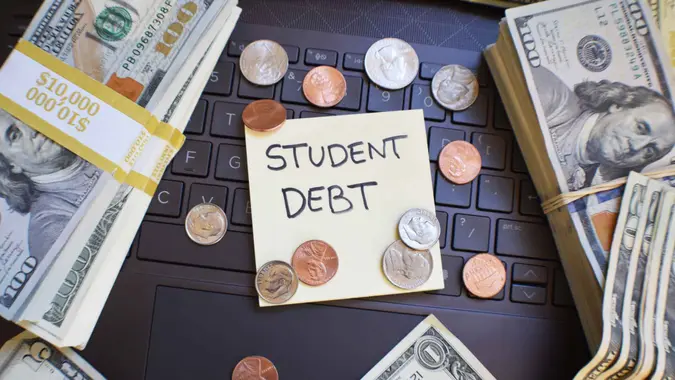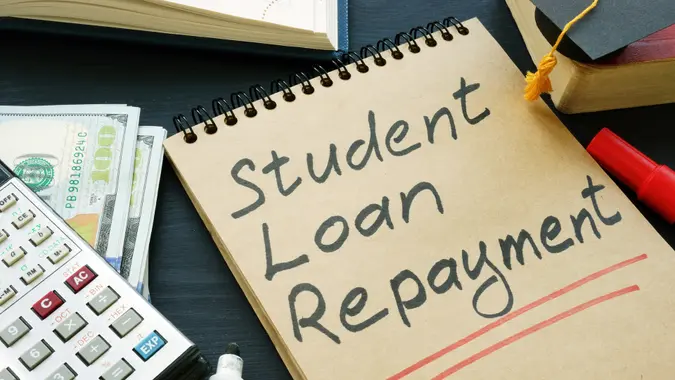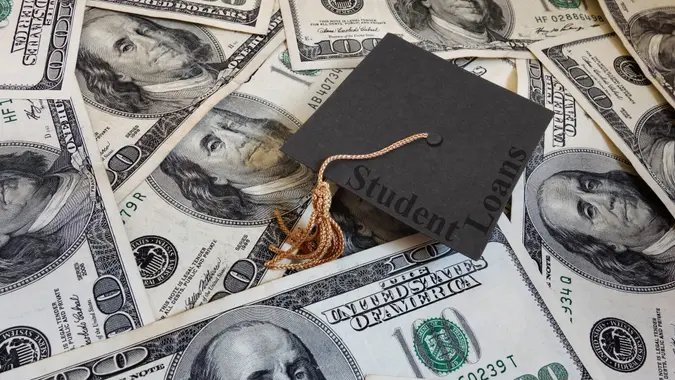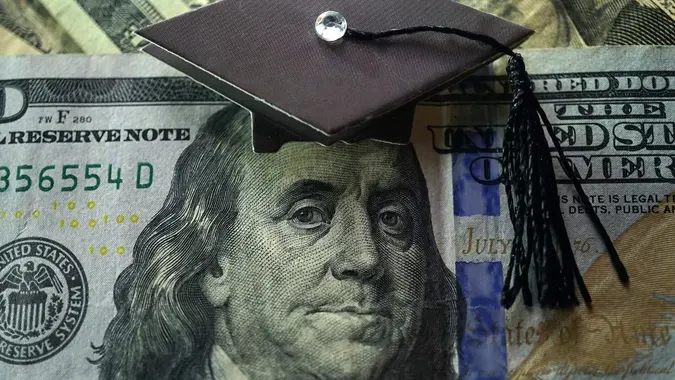4 Ways Trump Could Handle Student Loans in the Next 4 Years — Experts Weigh In

Commitment to Our Readers
GOBankingRates' editorial team is committed to bringing you unbiased reviews and information. We use data-driven methodologies to evaluate financial products and services - our reviews and ratings are not influenced by advertisers. You can read more about our editorial guidelines and our products and services review methodology.

20 Years
Helping You Live Richer

Reviewed
by Experts

Trusted by
Millions of Readers
Student loan borrowers are bracing for potential shifts in repayment plans, forgiveness programs and interest rates during President Donald Trump’s second term.
According to a recent Debt.com survey, 66% of student loan borrowers said they were concerned about how the president’s policies could affect their student loan debt.
GOBankingRates interviewed experts to get their insights on some ways Trump could handle student loans in the next four years.
Also see four reasons to put your student loan payments on autopay.
Interest Rate Increases
Ken Ruggiero, CEO and chairman of Ascent Funding, a private student lender, said that interest rates may increase due to inflation and economic policy shifts.
“The market currently reflects expectations of slower federal interest rate cuts due to inflationary pressures from Trump-era policies,” Ruggiero said. “While some might speculate that rates could drop later this year, this is uncertain and could go either way.”
Ruggiero said that federal student loan rates reset each July, based on the 10-year Treasury auction from May of the same year. Recently, yields for newly issued 10-year Treasury notes hit their highest level since 2007.
“If federal loan rates were reset today, they would be approximately 0.30% higher than their current levels,” Ruggiero said. “Similarly, private student loan rates may have recently increased.”
Repayment Plan Changes
Dennis Shirshikov, an entrepreneur and educational leader at Fullmind, said that Trump could simplify repayment structures by consolidating multiple plans.
“That could take the form of consolidation into fewer options, perhaps with interest rates lower and shaped to spur economic activity to be appealing to voters,” Shirshikov said. “Existing borrowers could find both relief and uncertainty, with the outcome depending closely on their specific situation.”
Experts also said the Trump administration could revive his 2017 student loan proposal.
“Reducing loan forgiveness timelines under IBR (income-based repayment) from 20 to 15 years for undergraduates might be appealing,” Ruggiero said. “However, this could come with the trade-off of being limited to a single repayment option — 12.5% of discretionary income (vs. the current 10%) — if the 2017 Trump proposal is revisited.”
Limits on Loan Forgiveness to Certain Careers
Instead of sweeping student loan forgiveness, the Trump administration could take a targeted approach.
“We might see incentives that are very, very closely aligned to job creation, like loan forgiveness for graduates who go into certain industries — manufacturing, technology or something that fits with his larger economic agenda such as healthcare,” Shirshikov said. “Such a targeted approach may also appeal politically, since not only does it address the underlying issue of labor shortages, but it also addresses the issue of student debt.”
However, if existing forgiveness programs were to change, some borrowers could be hurt. “But a dismantling of widespread forgiveness programs would likely hit hard those who are already relying on relief, such as public service workers,” Shirshikov said.
In addition, if the Trump administration takes a targeted approach to loan forgiveness, it could send signals to the next generation of borrowers.
“A student who had been looking at an arts degree is now steering toward cybersecurity or engineering if that degree gives them a shot at some student loan discounts, for example,” Shirshikov said.
Employer Incentives
One unexpected policy shift could involve providing tax incentives for companies that help workers pay off student loans. “Such efforts could change the corporate culture itself, making student loan repayment assistance a competitive hiring incentive, indirectly lightening the burden for scholars,” Shirshikov said.
Shirshikov said he observed some companies embrace this approach, which could dramatically increase employee enthusiasm and retention. “If adopted nationally, it would also help shift student debt from the shadows into a new cultural belonging, adding repayment assistance to the range of benefits businesses use to compete for workers,” Shirshikov said.
Nevertheless, experts said that any changes in student loan forgiveness will take time.
“Adjustments to loan terms, forgiveness programs or interest rates could significantly impact the overall cost of higher education for borrowers,” Ruggiero said. “If federal aid becomes more accessible or affordable, it could alleviate financial burdens on students and families. However, these benefits may take time to materialize, especially if legislative approval is required.”
Editor’s note on political coverage: GOBankingRates is nonpartisan and strives to cover all aspects of the economy objectively and present balanced reports on politically focused finance stories. You can find more coverage of this topic on GOBankingRates.com.
More From GOBankingRates
 Written by
Written by  Edited by
Edited by 






















